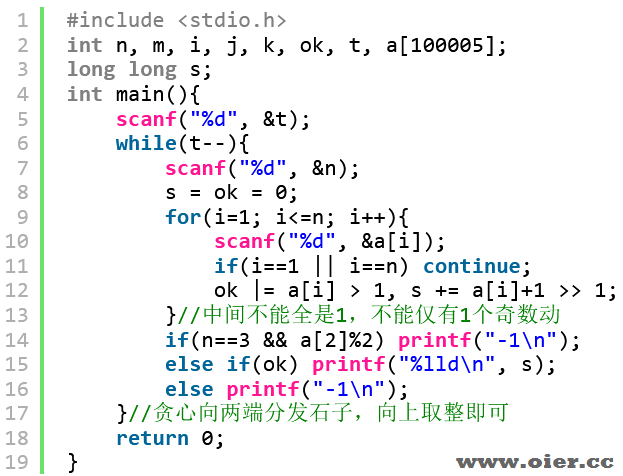题目大意:n堆石子,每次可以将中间一堆往左右任选一堆各放1个石子,至少多少次操作,才能只剩下第1堆和第n堆?
题意翻译
给定一个长度为 $n$ 的数组 $a$。你可以执行若干次操作,每次操作选定三个下标 $i,j,k$,需要保证 $1\leqslant i<j<k\leqslant n$ 且 $a_j\geqslant 2$,然后将 $a_i$ 替换为 $a_i+1$,将 $a_j$ 替换为 $a_j-2$,将 $a_k$ 替换为 $a_k+1$。你想使得 $\forall i\in[2,n-1]$,$a_i=0$。求需要的最少操作次数。
数据范围:
– $t$ 组数据,$1\leqslant t\leqslant 10^4$。
– $3\leqslant n,\sum n\leqslant 10^5$。
– $1\leqslant a_i\leqslant 10^9$。
Translated by Eason_AC
题目描述
Andrew has $ n $ piles with stones. The $ i $ -th pile contains $ a_i $ stones. He wants to make his table clean so he decided to put every stone either to the $ 1 $ -st or the $ n $ -th pile.
Andrew can perform the following operation any number of times: choose $ 3 $ indices $ 1 \le i < j < k \le n $ , such that the $ j $ -th pile contains at least $ 2 $ stones, then he takes $ 2 $ stones from the pile $ j $ and puts one stone into pile $ i $ and one stone into pile $ k $ .
Tell Andrew what is the minimum number of operations needed to move all the stones to piles $ 1 $ and $ n $ , or determine if it’s impossible.
输入输出格式
输入格式
The input contains several test cases. The first line contains one integer $ t $ ( $ 1 \leq t \leq 10\,000 $ ) — the number of test cases.
The first line for each test case contains one integer $ n $ ( $ 3 \leq n \leq 10^5 $ ) — the length of the array.
The second line contains a sequence of integers $ a_1, a_2, \ldots, a_n $ ( $ 1 \leq a_i \leq 10^9 $ ) — the array elements.
It is guaranteed that the sum of the values $ n $ over all test cases does not exceed $ 10^5 $ .
输出格式
输入输出样例
输入样例 #1
4
5
1 2 2 3 6
3
1 3 1
3
1 2 1
4
3 1 1 2输出样例 #1
4
-1
1
-1说明
In the first test case, it is optimal to do the following:
1. Select $ (i, j, k) = (1, 2, 5) $ . The array becomes equal to $ [2, 0, 2, 3, 7] $ .
2. Select $ (i, j, k) = (1, 3, 4) $ . The array becomes equal to $ [3, 0, 0, 4, 7] $ .
3. Twice select $ (i, j, k) = (1, 4, 5) $ . The array becomes equal to $ [5, 0, 0, 0, 9] $ . This array satisfy the statement, because every stone is moved to piles $ 1 $ and $ 5 $ .
There are $ 4 $ operations in total.In the second test case, it’s impossible to put all stones into piles with numbers $ 1 $ and $ 3 $ :
1. At the beginning there’s only one possible operation with $ (i, j, k) = (1, 2, 3) $ . The array becomes equal to $ [2, 1, 2] $ .
2. Now there is no possible operation and the array doesn’t satisfy the statement, so the answer is $ -1 $ .
In the third test case, it’s optimal to do the following:
1. Select $ (i, j, k) = (1, 2, 3) $ . The array becomes equal to $ [2, 0, 2] $ . This array satisfies the statement, because every stone is moved to piles $ 1 $ and $ 3 $ .
The is $ 1 $ operation in total.In the fourth test case, it’s impossible to do any operation, and the array doesn’t satisfy the statement, so the answer is $ -1 $ .
解题思路
每次中间部分减少2个石子,答案约为中间石子数量除以2。
考虑无解情况:如果中间只有一堆奇数石子,最后剩下1个无法移动;如果中间全是1的石子,第一次就无法操作;如果中间很多奇数堆,无所谓,只需要移动的时候,把某个奇数堆变成偶数即可,所以答案就是每堆石子数量除以2向上取整。
程序实现
